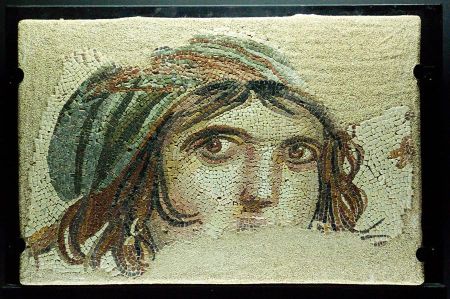Gaziantep - many secrets still unsolved!
- Written by Portal Editor
On our tour through the southeast we also reached Gaziantep, whose mosaics in the Zeugma Mosaic Museum are known far beyond the country's borders.
While the Archaeological Museum today shows finds from the area around the city and from Zincirli, Yesemek, Arsameia on Nymphaios and some other excavations, the large collection of Roman mosaics from the lost city of Zeugma on the middle Euphrates has now been moved to the Zeugma mosaic museum, which opened in 2011 been outsourced. The Zeugma mosaic museum is probably the largest mosaic museum in the world.
Museum of Anatolian Civilizations in Ankara
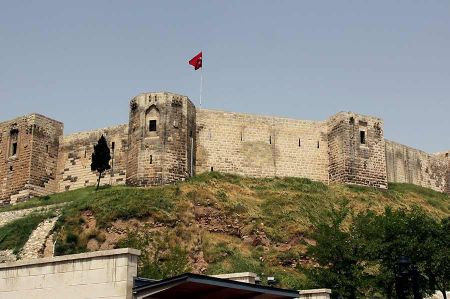 At the point where the Euphrates today leaves Turkey and flows into Syria, there was once Kargamış, an important historical place that was temporarily considered the capital of the late Hittite Empire.
At the point where the Euphrates today leaves Turkey and flows into Syria, there was once Kargamış, an important historical place that was temporarily considered the capital of the late Hittite Empire.
Many of the finds from Kargamış are on display at the Museum of Anatolian Civilizations in Ankara. Another once Hittite town worth seeing is Yesemek near İslahiye.
Between 1200 and 800 BC In the 4th century BC, this place was used by the Hittites as an open-air sculptor's studio and is therefore considered one of the oldest quarries in Anatolia. There are still 200 Hittite statues in the area around the town today.
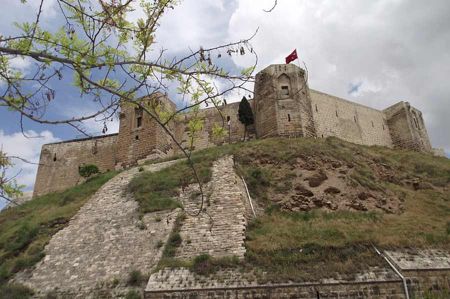 The area of today's city of Gaziantep was disputed between the Hittites and Assyrians for a long time in ancient times and only came under Assyrian rule under King Sargon II (721–705 BC). About ten kilometres north of Gaziantep was the city of Doliche, or Dülük in Turkish, which in the Roman imperial era was seen as the starting point of the cult of Jupiter Dolichenus, which, as many stone inscriptions attest, was able to spread from here with the Roman soldiers far into Central Europe. In 2010, German archaeologists and ancient historians researched the floor plans of extensive buildings on the summit of the Dülük Baba Tepesi hill, which probably once belonged to the sanctuary of the temple complex.
The area of today's city of Gaziantep was disputed between the Hittites and Assyrians for a long time in ancient times and only came under Assyrian rule under King Sargon II (721–705 BC). About ten kilometres north of Gaziantep was the city of Doliche, or Dülük in Turkish, which in the Roman imperial era was seen as the starting point of the cult of Jupiter Dolichenus, which, as many stone inscriptions attest, was able to spread from here with the Roman soldiers far into Central Europe. In 2010, German archaeologists and ancient historians researched the floor plans of extensive buildings on the summit of the Dülük Baba Tepesi hill, which probably once belonged to the sanctuary of the temple complex.
Where the Merziman torrent flows into the Euphrates
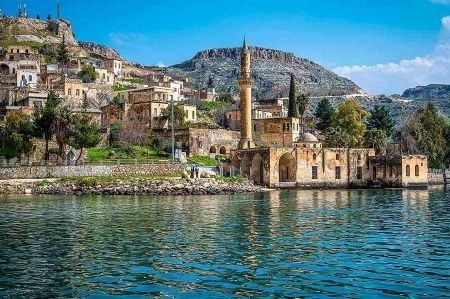 Where the Merziman torrent flows into the Euphrates, the so-called Rum Kale (Roman Castle) rises above steep rocks.
Where the Merziman torrent flows into the Euphrates, the so-called Rum Kale (Roman Castle) rises above steep rocks.
It has a special meaning for Christianity because it is believed that the first Bible was kept in it.
In the centre of the castle there is a cistern whose enormous depth reaches down to the water level of the Euphrates. Belkıs (Zeugma), 10 km from the district capital Nizip, was an important city in Roman times.
This place is particularly famous for its mosaics, unfortunately only some of which were found in museums.
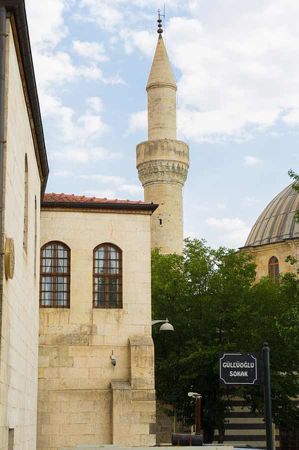 Antep was behind the city of Doliche until the year 637, when the Arabs advanced here, replaced the Eastern Roman rule and conquered Doliche, after which it slowly lost its rank.
Antep was behind the city of Doliche until the year 637, when the Arabs advanced here, replaced the Eastern Roman rule and conquered Doliche, after which it slowly lost its rank.
After their invasion of eastern Anatolia, the Turkish Seljuks, who had defeated the army of Emperor Romanos IV Diogenes (1068–1071) in the Battle of Manzikert on August 26, 1071, took control of this area. At that time, the fortress was built on the city hill of Antep.
The citadel from Seljuk times, which is now in the centre of the city, was probably the site of fortifications in ancient times. Some scholars even suspect that Gaziantep corresponds to or was close to the Seleucid city of Antioch ad Taurum.
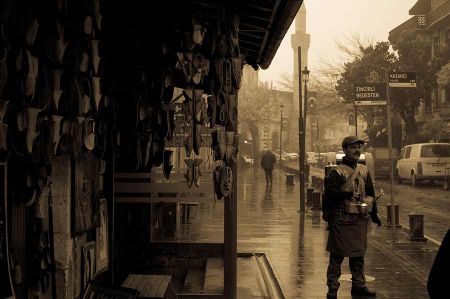 As part of the Crusades, Antep came to the Western Knights in 1098 and has since then belonged to the Principality of Antioch. In 1183 Sultan Saladin conquered the city. After his death at the beginning of March 1193, rule in this area was disputed, including between the Mamluks and Mongols. In 1514, the Turkish Sultan Selim I (1512–1520) conquered southeastern Anatolia and with it Antep. Since then, the city has belonged to the Ottoman Empire; Between 1832 and 1840 it was occupied by the troops of the Egyptian governor Muhammad Ali Pasha. At the end of the First World War, British units occupied the region in 1918; They were followed by the French until their expulsion by Sahin Bey in 1921. With the Treaty of Lausanne on July 24, 1923, the city now called Gaziantep became part of the Republic of Turkey.
As part of the Crusades, Antep came to the Western Knights in 1098 and has since then belonged to the Principality of Antioch. In 1183 Sultan Saladin conquered the city. After his death at the beginning of March 1193, rule in this area was disputed, including between the Mamluks and Mongols. In 1514, the Turkish Sultan Selim I (1512–1520) conquered southeastern Anatolia and with it Antep. Since then, the city has belonged to the Ottoman Empire; Between 1832 and 1840 it was occupied by the troops of the Egyptian governor Muhammad Ali Pasha. At the end of the First World War, British units occupied the region in 1918; They were followed by the French until their expulsion by Sahin Bey in 1921. With the Treaty of Lausanne on July 24, 1923, the city now called Gaziantep became part of the Republic of Turkey.
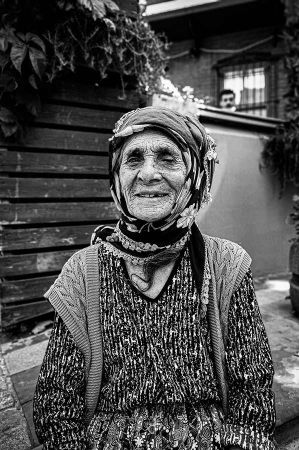 Gaziantep is located on the well-known Baghdad Railway, which, however, could only go into operation after the founding of modern Turkey in order to bypass the section of the route that is now in Syria. Passenger traffic on the railway line to Mosul (Iraq) was only reopened in mid-February 2010, but this has now been stopped again. The 18-hour trip over Syria took place once a week in 2010.
Gaziantep is located on the well-known Baghdad Railway, which, however, could only go into operation after the founding of modern Turkey in order to bypass the section of the route that is now in Syria. Passenger traffic on the railway line to Mosul (Iraq) was only reopened in mid-February 2010, but this has now been stopped again. The 18-hour trip over Syria took place once a week in 2010.
Gaziantep also set up a light rail system for its public transport, comparable to Antalya. As early as 2009, 17 former Düwag subway and tram railcars of the Pt type were purchased from Frankfurt am Main, which have no longer been used in Frankfurt since April 1, 2007. They were transported by rail to Gaziantep, where they were modernized and used. The tram line, which runs from the university to the train station and is around 13 kilometres long, was opened in 2011. However, the connection was discontinued shortly after it went into operation due to lack of interest.
Please read as well:
Submerged in the floods of the Euphrates: Zeugma
The Diocletian's Aqueduct in Split
https://www.alaturka.info/en/turkey-country/southeastern/1648-gaziantep-past-and-present?tmpl=component&print=1&layout=default&page=#sigProId1ec3d0ad3a
